Page 534 of 602
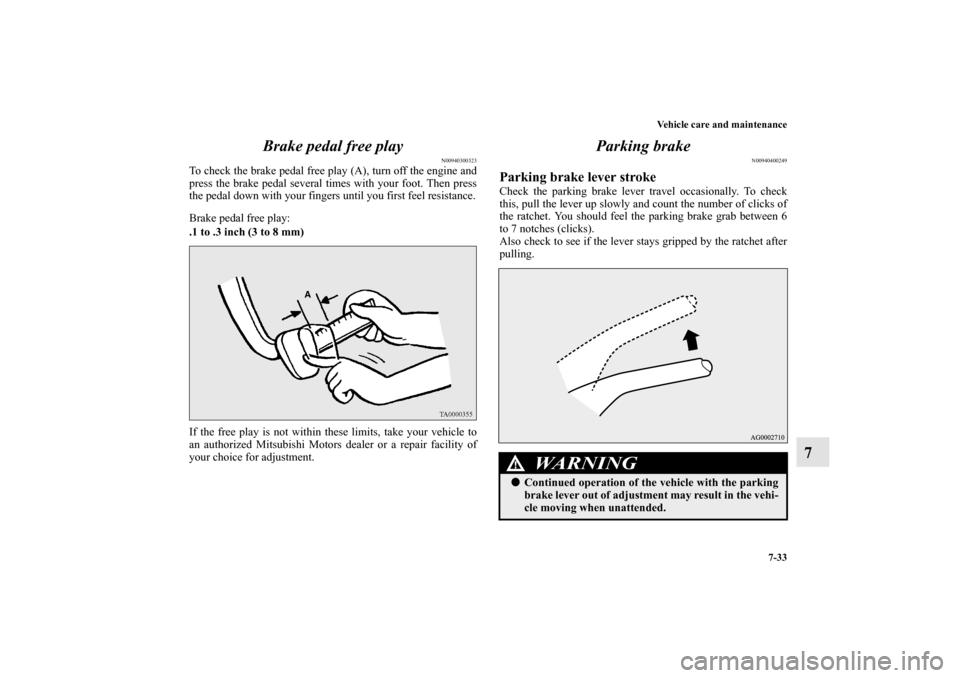
Vehicle care and maintenance7-33
7
Brake pedal free play
N00940300323
To check the brake pedal free play (A), turn off the engine and
press the brake pedal several times with your foot. Then press
the pedal down with your fingers until you first feel resistance.
Brake pedal free play:
.1 to .3 inch (3 to 8 mm)
If the free play is not within these limits, take your vehicle to
an authorized Mitsubishi Motors dealer or a repair facility of
your choice for adjustment.
Parking brake
N00940400249
Parking brake lever strokeCheck the parking brake lever travel occasionally. To check
this, pull the lever up slowly and count the number of clicks of
the ratchet. You should feel the parking brake grab between 6
to 7 notches (clicks).
Also check to see if the lever stays gripped by the ratchet after
pulling.
WARNING
!�
Continued operation of the vehicle with the parking
brake lever out of adjustment may result in the vehi-
cle moving when unattended.
BK0150700US.book 33 ページ 2012年3月22日 木曜日 午後6時46分
Page 536 of 602
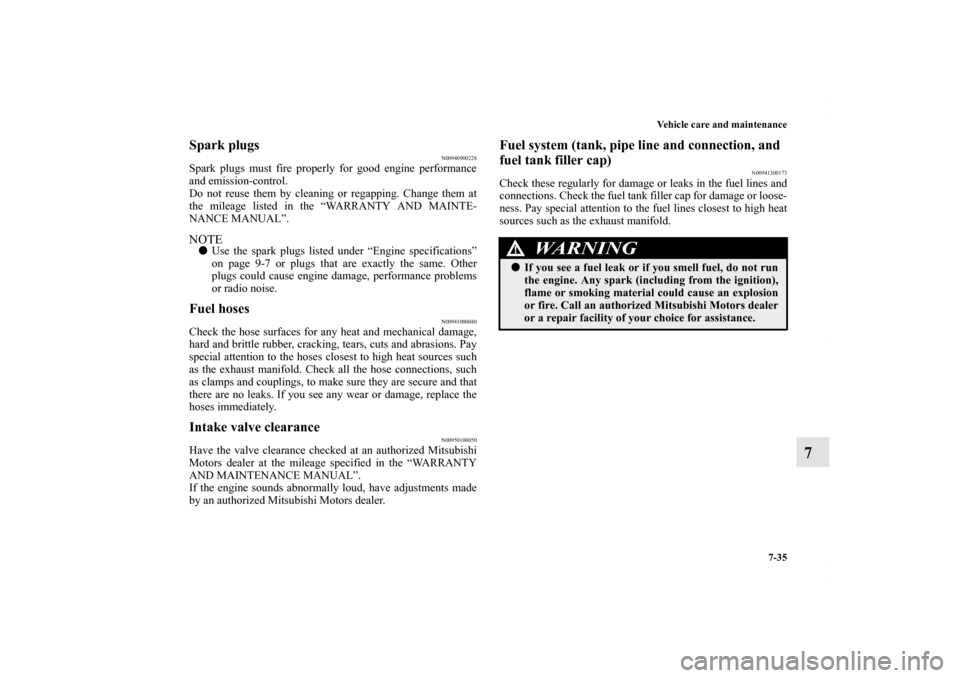
Vehicle care and maintenance7-35
7
Spark plugs
N00940900228
Spark plugs must fire properly for good engine performance
and emission-control.
Do not reuse them by cleaning or regapping. Change them at
the mileage listed in the “WARRANTY AND MAINTE-
NANCE MANUAL”. NOTE�Use the spark plugs listed under “Engine specifications”
on page 9-7 or plugs that are exactly the same. Other
plugs could cause engine damage, performance problems
or radio noise.Fuel hoses
N00941000040
Check the hose surfaces for any heat and mechanical damage,
hard and brittle rubber, cracking, tears, cuts and abrasions. Pay
special attention to the hoses closest to high heat sources such
as the exhaust manifold. Check all the hose connections, such
as clamps and couplings, to make sure they are secure and that
there are no leaks. If you see any wear or damage, replace the
hoses immediately.Intake valve clearance
N00950100050
Have the valve clearance checked at an authorized Mitsubishi
Motors dealer at the mileage specified in the “WARRANTY
AND MAINTENANCE MANUAL”.
If the engine sounds abnormally loud, have adjustments made
by an authorized Mitsubishi Motors dealer.
Fuel system (tank, pipe line and connection, and
fuel tank filler cap)
N00941300173
Check these regularly for damage or leaks in the fuel lines and
connections. Check the fuel tank filler cap for damage or loose-
ness. Pay special attention to the fuel lines closest to high heat
sources such as the exhaust manifold.
WARNING
!�If you see a fuel leak or if you smell fuel, do not run
the engine. Any spark (including from the ignition),
flame or smoking material could cause an explosion
or fire. Call an authorized Mitsubishi Motors dealer
or a repair facility of your choice for assistance.
BK0150700US.book 35 ページ 2012年3月22日 木曜日 午後6時46分
Page 538 of 602
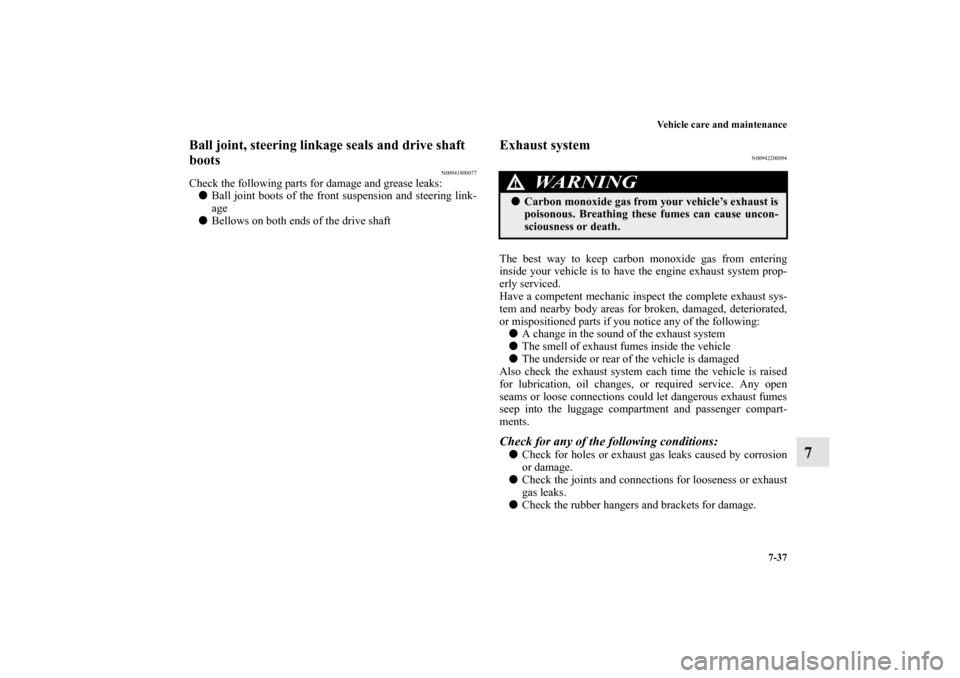
Vehicle care and maintenance7-37
7
Ball joint, steering linkage seals and drive shaft
boots
N00941800077
Check the following parts for damage and grease leaks:� Ball joint boots of the front suspension and steering link-
age
� Bellows on both ends of the drive shaft
Exhaust system
N00942200094
The best way to keep carbon monoxide gas from entering
inside your vehicle is to have the engine exhaust system prop-
erly serviced.
Have a competent mechanic inspect the complete exhaust sys-
tem and nearby body areas for broken, damaged, deteriorated,
or mispositioned parts if you notice any of the following:
� A change in the sound of the exhaust system
� The smell of exhaust fumes inside the vehicle
� The underside or rear of the vehicle is damaged
Also check the exhaust system each time the vehicle is raised
for lubrication, oil changes, or required service. Any open
seams or loose connections could let dangerous exhaust fumes
seep into the luggage compartment and passenger compart-
ments.Check for any of the following conditions:� Check for holes or exhaust gas leaks caused by corrosion
or damage.
� Check the joints and connections for looseness or exhaust
gas leaks.
� Check the rubber hangers and brackets for damage.
WARNING
!�Carbon monoxide gas from your vehicle’s exhaust is
poisonous. Breathing these fumes can cause uncon-
sciousness or death.
BK0150700US.book 37 ページ 2012年3月22日 木曜日 午後6時46分
Page 540 of 602
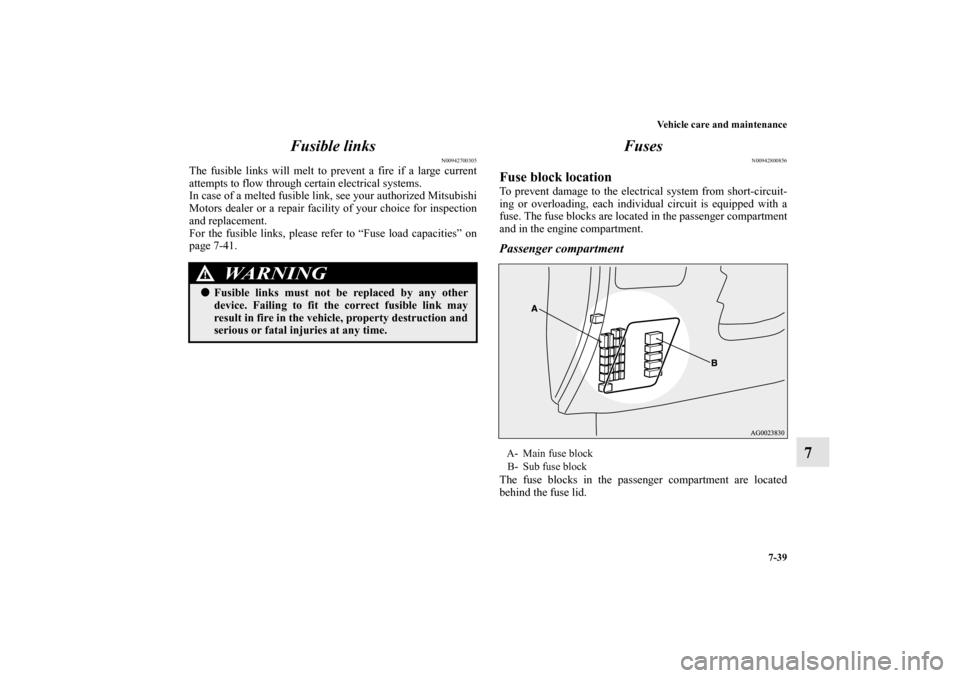
Vehicle care and maintenance7-39
7
Fusible links
N00942700305
The fusible links will melt to prevent a fire if a large current
attempts to flow through certain electrical systems.
In case of a melted fusible link, see your authorized Mitsubishi
Motors dealer or a repair facility of your choice for inspection
and replacement.
For the fusible links, please refer to “Fuse load capacities” on
page 7-41.
Fuses
N00942800856
Fuse block locationTo prevent damage to the electrical system from short-circuit-
ing or overloading, each individual circuit is equipped with a
fuse. The fuse blocks are located in the passenger compartment
and in the engine compartment.Passenger compartmentThe fuse blocks in the passenger compartment are located
behind the fuse lid.
WARNING
!�
Fusible links must not be replaced by any other
device. Failing to fit the correct fusible link may
result in fire in the vehicle, property destruction and
serious or fatal injuries at any time.
A- Main fuse block
B- Sub fuse block
BK0150700US.book 39 ページ 2012年3月22日 木曜日 午後6時46分
Page 543 of 602
7-42 Vehicle care and maintenance
7
*: Fusible link� Some fuses may not be installed on your vehicle, depend-
ing on the vehicle model or specifications.
� The table above shows the main equipment corresponding
to each fuse.
No.
Symbol
Electrical system
Capacity
1 Heater30 A*
2 Stop lights
(Brake lights) 15 A
3 Rear fog light 10 A
4 Windshield wiper 30 A
5 Optional10 A
6 Door locks20 A
7 Radio15 A
8 Control unit relay 7.5 A
9 Interior lights
(Dome lights) 15 A
10 Hazard warning flasher 15 A
11 Rear window wiper 15 A
12 Gauges7.5 A
13 Cigarette lighter
/Accessory socket 15 A
14 Ignition
Switch 10 A
15 Sunroof20 A
16 Outside rearview mirrors 10 A
17 All-wheel drive system 10 A
18 Back-up lights 7.5 A
19 Accessory socket 15 A
20 Power window control 30 A*
21 Defogger30 A*
22 Heated door mirror 7.5 A
23 Passenger’s power seat 25 (20) A
24 Driver’s power seat 25 (20) A
25 Heated seats30 ANo.
Symbol
Electrical system
Capacity
BK0150700US.book 42 ページ 2012年3月22日 木曜日 午後6時46分
Page 550 of 602
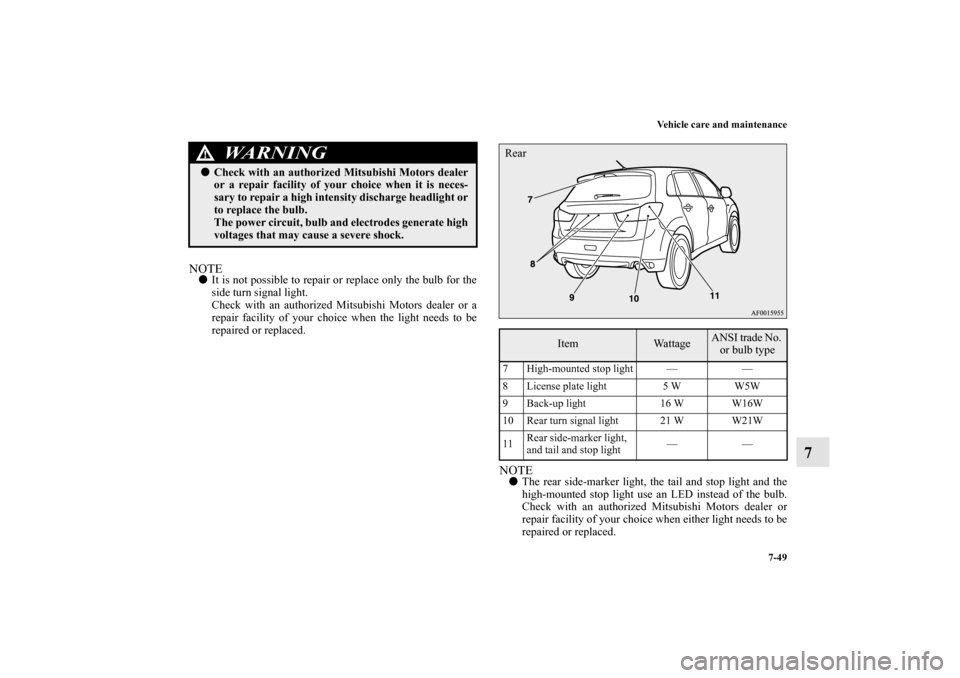
Vehicle care and maintenance7-49
7
NOTE�It is not possible to repair or replace only the bulb for the
side turn signal light.
Check with an authorized Mitsubishi Motors dealer or a
repair facility of your choice when the light needs to be
repaired or replaced.
NOTE�The rear side-marker light, the tail and stop light and the
high-mounted stop light use an LED instead of the bulb.
Check with an authorized Mitsubishi Motors dealer or
repair facility of your choice when either light needs to be
repaired or replaced.
WARNING
!�Check with an authorized Mitsubishi Motors dealer
or a repair facility of your choice when it is neces-
sary to repair a high intensity discharge headlight or
to replace the bulb.
The power circuit, bulb and electrodes generate high
voltages that may cause a severe shock.
Item
Wattage
ANSI trade No.
or bulb type
7 High-mounted stop light — —
8 License plate light 5 W W5W
9 Back-up light 16 W W16W
10 Rear turn signal light 21 W W21W
11 Rear side-marker light,
and tail and stop light ——Rear
BK0150700US.book 49 ページ
2012年3月22日 木曜日 午後6時46分
Page 555 of 602
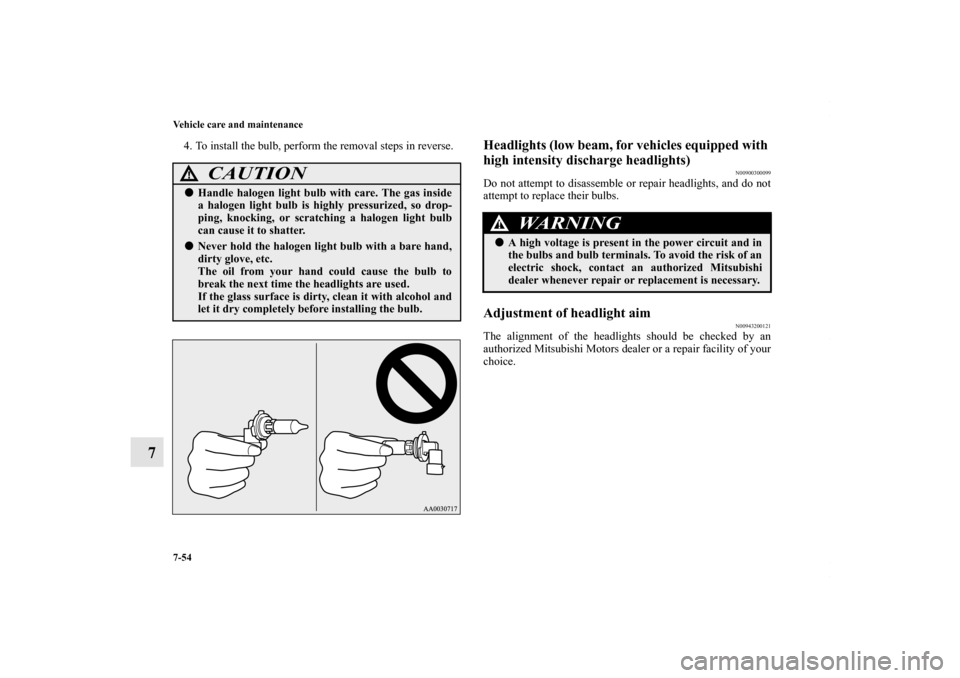
7-54 Vehicle care and maintenance
7
4. To install the bulb, perform the removal steps in reverse.
Headlights (low beam, for vehicles equipped with
high intensity discharge headlights)
N00900300099
Do not attempt to disassemble or repair headlights, and do not
attempt to replace their bulbs.Adjustment of headlight aim
N00943200121
The alignment of the headlights should be checked by an
authorized Mitsubishi Motors dealer or a repair facility of your
choice.
CAUTION
!�Handle halogen light bulb with care. The gas inside
a halogen light bulb is highly pressurized, so drop-
ping, knocking, or scratching a halogen light bulb
can cause it to shatter.�Never hold the halogen light bulb with a bare hand,
dirty glove, etc.
The oil from your hand could cause the bulb to
break the next time the headlights are used.
If the glass surface is dirty, clean it with alcohol and
let it dry completely before installing the bulb.
WARNING
!� A high voltage is present in the power circuit and in
the bulbs and bulb terminals. To avoid the risk of an
electric shock, contact an authorized Mitsubishi
dealer whenever repair or replacement is necessary.
BK0150700US.book 54 ページ 2012年3月22日 木曜日 午後6時46分
Page 579 of 602
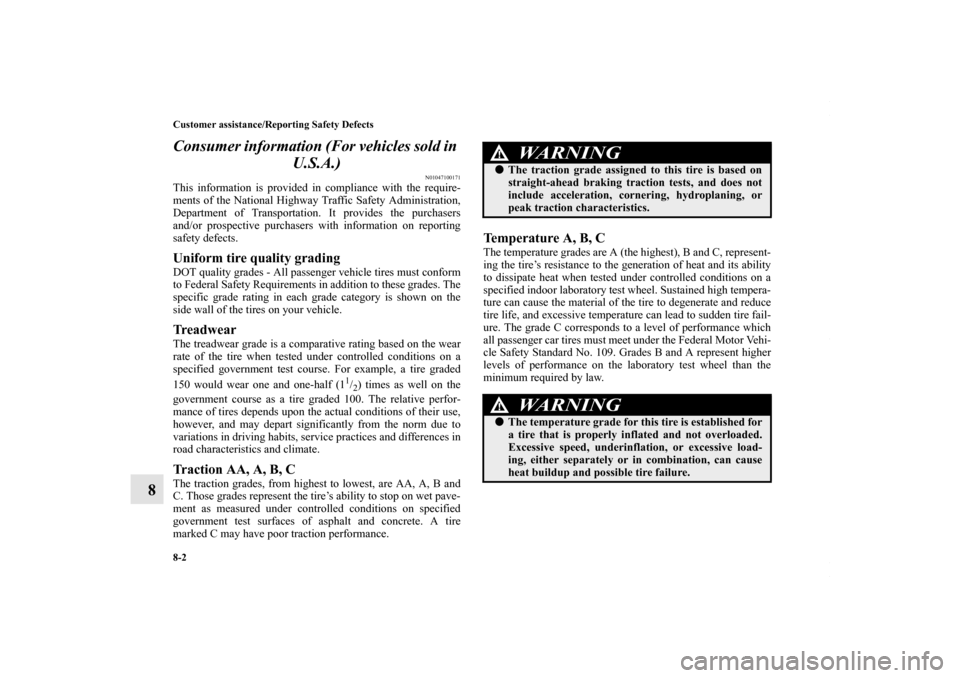
8-2 Customer assistance/Reporting Safety Defects
8Consumer information (For vehicles sold in
U.S.A.)
N01047100171
This information is provided in compliance with the require-
ments of the National Highway Traffic Safety Administration,
Department of Transportation. It provides the purchasers
and/or prospective purchasers with information on reporting
safety defects. Uniform tire quality gradingDOT quality grades - All passenger vehicle tires must conform
to Federal Safety Requirements in addition to these grades. The
specific grade rating in each grade category is shown on the
side wall of the tires on your vehicle. Treadwear The treadwear grade is a comparative rating based on the wear
rate of the tire when tested under controlled conditions on a
specified government test course. For example, a tire graded
150 would wear one and one-half (1
1/2) times as well on the
government course as a tire graded 100. The relative perfor-
mance of tires depends upon the actual conditions of their use,
however, and may depart significantly from the norm due to
variations in driving habits, service practices and differences in
road characteristics and climate.
Traction AA, A, B, C The traction grades, from highest to lowest, are AA, A, B and
C. Those grades represent the tire’s ability to stop on wet pave-
ment as measured under controlled conditions on specified
government test surfaces of asphalt and concrete. A tire
marked C may have poor traction performance.
Temperature A, B, CThe temperature grades are A (the highest), B and C, represent-
ing the tire’s resistance to the generation of heat and its ability
to dissipate heat when tested under controlled conditions on a
specified indoor laboratory test wheel. Sustained high tempera-
ture can cause the material of the tire to degenerate and reduce
tire life, and excessive temperature can lead to sudden tire fail-
ure. The grade C corresponds to a level of performance which
all passenger car tires must meet under the Federal Motor Vehi-
cle Safety Standard No. 109. Grades B and A represent higher
levels of performance on the laboratory test wheel than the
minimum required by law.
WARNING
!� The traction grade assigned to this tire is based on
straight-ahead braking traction tests, and does not
include acceleration, cornering, hydroplaning, or
peak traction characteristics.
WARNING
!�The temperature grade for this tire is established for
a tire that is properly inflated and not overloaded.
Excessive speed, underinflation, or excessive load-
ing, either separately or in combination, can cause
heat buildup and possible tire failure.
BK0150700US.book 2 ページ 2012年3月22日 木曜日 午後6時46分